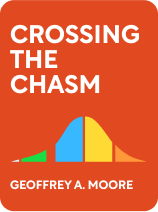

This article is an excerpt from the Shortform book guide to "Crossing the Chasm" by Geoffrey Moore. Shortform has the world's best summaries and analyses of books you should be reading.
Like this article? Sign up for a free trial here .
Why do most new, high-tech products fail to reach the stage of mass adoption? What are some examples of products that died in the chasm?
In his book Crossing the Chasm, Moore discusses two products that failed to cross the chasm: Segway’s personal transportation device and Motorola’s Iridium network. In both cases, Moore argues, they failed to reach the chasm stage due to technical limitations.
Keep reading to learn why most high-tech products die before crossing the chasm—with examples.
Products That Died in the Chasm
To further drive home the dangers of the chasm period, Geoffrey Moore illustrates how high-tech products die before crossing the chasm with examples from Segway and Motorola.
According to Moore, personal transportation device Segway failed to break into the mainstream market because it couldn’t navigate stairs. He likewise cites Motorola’s Iridium network, a satellite phone system that never caught on with mainstream customers because it had poor signal reception indoors.
However, the technical nature of these product failures begs the question of whether they actually died in the chasm, or before they even got there. According to Moore, one of the key distinctions between the early and mainstream markets is that early-market customers evaluate a technology based on its own technical merit, whereas mainstream-market customers evaluate it mostly based on reputation and market share.
Thus, if a product fails due to publicized technical limitations, such as the inability of a mobility device to climb stairs, or a phone’s poor reception, it seems likely that it was still in the early market at the time of its demise. If Segway failed because it couldn’t climb stairs and Iridium failed because its signal couldn’t penetrate walls, then it would appear that both these products died before they reached the chasm.
Other Perspectives on Segway’s Failure
In the case of the Segway, others have offered a variety of explanations for its failure in the market. For one thing, there is an active market for scooters and bicycles and similar transportation devices that don’t climb stairs. However, rather than competing for a share of the scooter market, Segway presented its product as an alternative to walking. Arguably, it was only this marketing decision that made stairs a problem for the Segway.
So, why didn’t the Segway company just pivot its marketing strategy, and take over the scooter market?
For one thing, their product retailed for about $5,000, which was roughly 10 times more than a motorized scooter, and 100 times more than a non-motorized scooter. The price alone put it out of reach of a large percentage of scooter buyers.
The Segway also looked different from other scooters, and became a punchline for making its users look like “dorks.” This further narrowed the potential customer base.
Furthermore, the safety of the Segway was called into question, particularly after the owner of the company accidentally ran his Segway off a cliff and died in the crash.In the end, it appears Segway was unable to identify any compelling application where none of these concerns would have been show stoppers. Thus, the Segway may actually have died in the application gap, rather than the chasm: A few innovators thought it was cool, but it wasn’t practical enough to attract early adopters.

———End of Preview———
Like what you just read? Read the rest of the world's best book summary and analysis of Geoffrey Moore's "Crossing the Chasm" at Shortform .
Here's what you'll find in our full Crossing the Chasm summary :
- An explanation of the chasm phenomenon that many new high-tech products face
- How to pilot a product across this chasm to mainstream success
- The problems with the Technology Adoption Life Cycle (TALC) model






